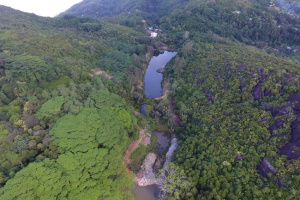Gabion technology could increase fresh water retention in Seychelles
General |Author: Shaorn Ernesta | May 8, 2021, Saturday @ 16:59| 10890 views
"The new reservoirs at Bougainville “has resulted in an increased resilience to climate change and benefits for water supply for human consumption, food security and livelihoods.” (Terence Vel)
(Seychelles News Agency) - Rehabilitating existing wetlands by constructing barrages using the gabion technology to increase water retention may be the way of securing more freshwater sources in Seychelles, an expert said.
The “Dan Sours” Bougainville wetland was recently restored with the first-ever gabion rock barrage at the Bougainville wetland in the district of Takamaka in the south of the main island of Mahe in 2018.
Johan Mendez, the project consultant, told SNA that the creation of the new reservoirs at Bougainville “has resulted in an increased resilience to climate change and benefits for water supply for human consumption, food security and livelihoods.”
Mendez explains that the approach presents an alternative to desalination for potable water production and the sustainability of our environment. Seychelles – 115 islands in the western Indian Ocean - has five desalination plants that contribute to potable water demands, especially during the drought session.
According to Mendez, those filtering dams increase storage capacity but they also play an important role by harnessing the resource instead of letting the water flow down to the sea. “The water is used for infiltration in the soil which then regulates the river flow downstream guaranteeing a constant water supply for the river users in the area.”
 |
| The “Dan Sours” Bougainville wetland was restored with the first-ever gabion rock barrage at the Bougainville wetland in 2018. (Seychelles Nation) Photo License: CC-BY |
“In rivers, gabion rock weirs act as filters and allow the creation of a wetland ecosystem when they are combined with plant engineering. As its first function is to retain water, it is the cornerstone of man-made wetland ecosystem, entire ecosystems, that functions in and around the water,” explained Mendez.
Once completed, the Bougainville wetland, “is going to look like a giant Mare-aux-Cochon with a lot of endemics palms and vacoas around, also a rich biodiversity in and around with an entire ecosystem, that functions in and around the water.” Mare-aux-Cochon is one of the largest freshwater sources on the island nation.
The area now features a thriving forest of endemic palms, an all-around trail, bridges, benches, a parking facility and litter bins. It offers families a perfect getaway for picnics, to relax, do exercises, meditate, do yoga and at the same time respecting the environment.
The consultant added that “the area will be proposed to be nominated as a protected area as it is already classified as a catchment forest. But it could be used also as a demonstration site for sustainable agroforestry and permaculture.” Mendez said that EBA’s first wetland rehabilitation using the gabion technology is a real success and giving humanity a lesson.
 |
| Mendez explains that the approach presents an alternative to desalination for potable water production and the sustainability of our environment. (Salifa Karapetyan) Photo License: CC-BY |
“When you help her, the benefits given by nature is bigger and it is hard to financially evaluate the full value of this ecosystem services. The aquatic species, birds and humans are benefiting from its many services nesting sites, water and food supply, carbon absorption, stormwater detention, education and relaxing area for leisure and recreation. It is now a duty to take care of this natural asset if we still want to benefit from all of it.”
And tasked with ensuring the area is looked after and protected is the Bougainville Watershed Committee. Alice Confiance a member told SNA the wetland is the pride of the community. “The transformation of the wetland to what it is today from five years ago is truly a labour of love. We had to clean the area and also do several tree plantings to ensure that the area keeps its forest appearance,” explained Confiance.
Confiance adds that the area is now a beautiful area for people to come to appreciate what nature can offer but reminds all that the area should be used responsibly with no vandalism and strictly no littering. “Dan Sours is our gift to the future generation,” she added.
Back
